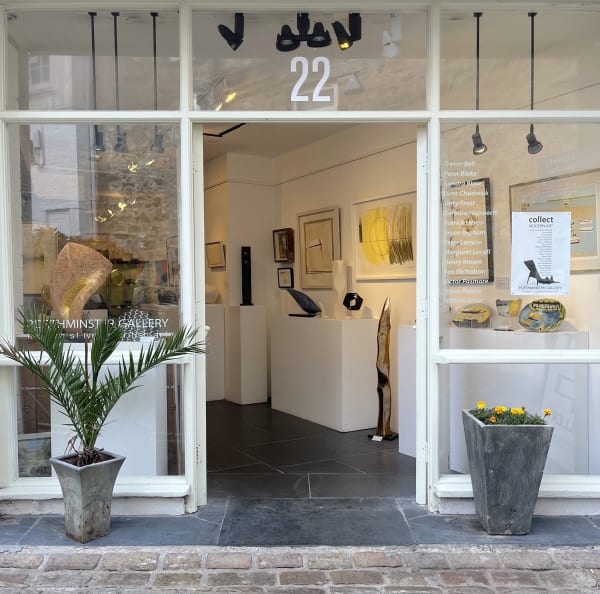Wilhelmina Barns-Graham CBE Scottish, 1912-2004
Wilhelmina Barns-Graham was born in St Andrews and attended Edinburgh College of Art between 1932-7. She moved to St Ives in the 1940s, where she joined the artist societies of Newlyn, St Ives and Penwith and became friends with Ben Nicholson, Barbara Hepworth and Naum Gabo. A trip to Switzerland in 1948 inspired her Glacier Series and further significant travel to Italy in 1955 highlighted her strong draughtsmanship. She divided her time between St Andrews and St Ives from 1960 and produced various significant series of abstract works from the geometric to the more organic.
Later in her life, her work took on a colourful, painterly flourishing in tandem with magnificent printmaking with Graal Press, consolidating her place as a leading 20th Century British artist.
After her education Barns-Graham made study trips to Paris, London and St Tropez before moving to St Ives, Cornwall in 1940 at the suggestion of the Edinburgh College of Art's Principal Hubert Wellington. Barns-Graham moved near to where a group of modernist artists had settled, at Carbis Bay. This was a pivotal moment in her life. On one of her first evenings there she met the sculptor Barbara Hepworth who made an immediate and lasting impression on her she then went on to meet Borlase Smart, Alfred Wallis and Bernard Leach, as well as the painter Ben Nicholson and the sculptors Naum Gabo and Margaret Mellis. After two weeks in St Ives, Barns-Graham acquired her first studio, directly below the Porthmeor Gallery which was the administrative headquarters of the St Ives Society of Artists. Her paintings at the time were heavily influenced by the Cornish landscapes and the St Ives harbour. During 1940 and 1941 Barns-Graham contributed to the war effort by volunteering in a factory making camouflage nets however using the rough materials gave her dermatitis so she had to give up the work, instead knitting string vests and socks.
In 1942 Barns-Graham became a member of the Newlyn Society of Artists, in which she exhibited with every year, and the St Ives Society of Artists. Whilst establishing herself in St Ives, Barns-Graham also continued to send work back to Scotland for major exhibitions held there such as the Royal Scottish Academy's 117th Exhibition in 1943.[5] The 1940s were an active time for the St Ives Society of Artists who received a number of invitations to send exhibitions and groups of works to galleries in the UK and abroad, Barns-Graham's work was always included in these as the Society's secretary, Borlase Smart, thought highly of her work.
After the war the number of young modern artists joining the St Ives Society of Artists increased, of which Barns-Graham was one, their works were often shown in the darkly lit font area of the New Gallery of the Mariners' Church which gave them the nickname 'The Artists Around the Font'. There was deemed to be hostility from the more traditional artists of the Society so Barns-Graham and the other modern artists decided to exhibit their work separately in the crypt area of the New Gallery, calling themselves the Crypt Group. The use of the crypt as an exhibition space caught on and was used again a number of times to exhibit the work of the young modernist members of the St Ives Society of Artists, including in March 1947 where seventeen artists exhibited work, including Barns-Graham, Ben Nicholson, Barbara Hepworth and Peter Lanyon.
Barns-Graham's first opportunity to exhibit in London came when her work was included in a group exhibition of six at the Redfern Gallery. This was due to the introduction and support of Patrick Heron who visited Barns-Graham's studio in St Ives and was excited by her work.[5] Barns-Graham would later have her first one-person exhibition in London at Redfern in 1952.
After a few years of tension, Barns-Graham eventually left the St Ives Society of Artists in 1949, becoming one of the founding members of a new breakaway group named Penwith Society of Arts. The first Penwith Society exhibition opened in June 1949 with huge success and 2755 paying visitors coming to see it.
In the same year she married the young author and aspiring poet, and later noted architect, David Lewis; the marriage was annulled in 1960.
In 1950 Barns-Graham's painting Upper Glacier was purchased by the British Council, this was her largest sale she had made so far and the following year the work was also included in Herbert Read's book Contemporary British Art. Barns-Graham's work was also increasingly being included in London exhibitions such as the Leicester Galleries Artists of Fame and Promise and the inaugural exhibition at the new Institute of Contemporary Arts premises. In 1951 Barns-Graham's work was also included in international exhibitions such as the Biennale de Peinture de France, where Barns-Graham was one of only eight British artists invited to contribute.
-

COLLECT | MODERN ART
9 Sep - 4 Nov 2023Gallery exhibition of Modern St Ives and British art for sale, featuring art – paintings, prints, drawings, and sculptures – by leading 20th Century artists, including: Wilhelmina BARNS-GRAHAM, Peter BLAKE, Sandra BLOW, Patrick CAULFIELD, Lynn CHADWICK, Maurice COCKRILL, Terry FROST, Barbara HEPWORTH, Patrick HERON, David HOCKNEY, Bryan INGHAM, Albert IRVIN, Margaret LOVELL, Henry MOORE, Ben NICHOLSON, Victor PASMORE, Bryan PEARCE, Tommy ROWE, William SCOTT, Joe TILSON.Read more -

COLLECT: MODERN ART
Exhibition of original art by leading 20th Century St Ives & British Artists 12 Mar - 30 Apr 2021Our annual selling exhibition of original art by leading 20th Century St Ives and British Artists, provides exciting opportunities for new and seasoned collectors alike. With the boost in growth...Read more -

RELOCATION
11 Sep - 24 Oct 2020The opening collection at our new premises at 22 Fore Street is a changing showcase of artworks by some of the many established and emerging British Artists whom we represent,...Read more





